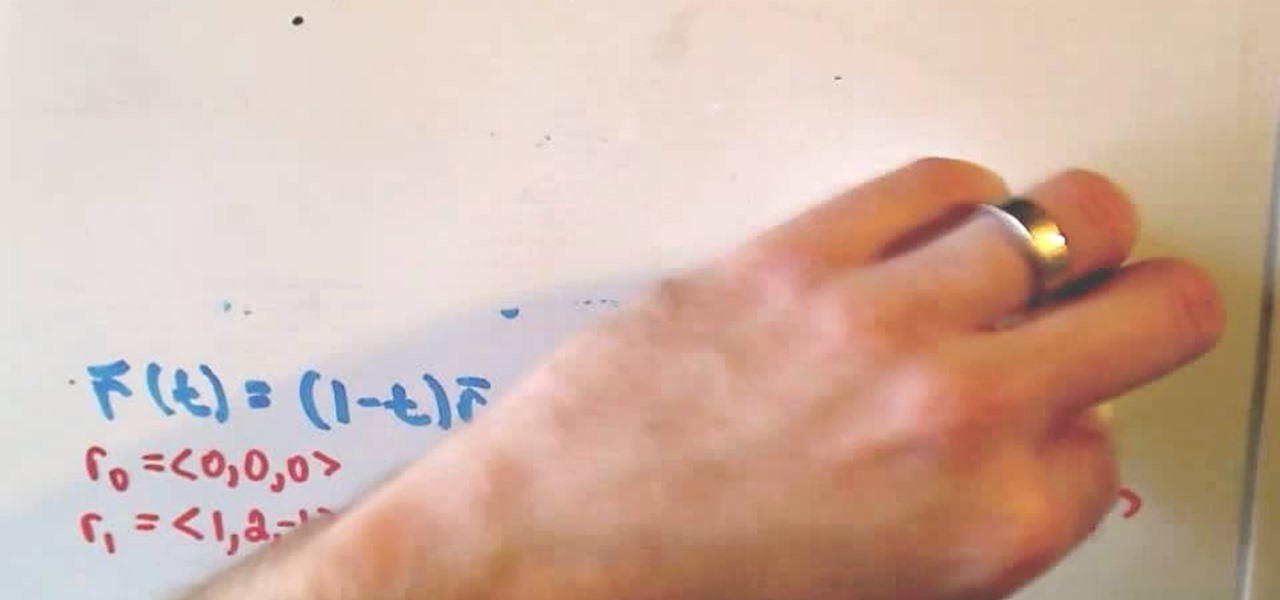Math How-Tos


How To: Add two digit numbers
Addition got you down? An expert instructor from Khan Academy walks you through the mysteries of adding two numbers together by breaking it down into easy to understand terms. Fun animated chalkboard examples make it easy for kids and adults alike to learn how to add. Also demonstrates how to add using the number line. Introduces the concept of numbers less than zero. Includes addition of both large and small numbers, and how to carry over the numbers on more complex problems.
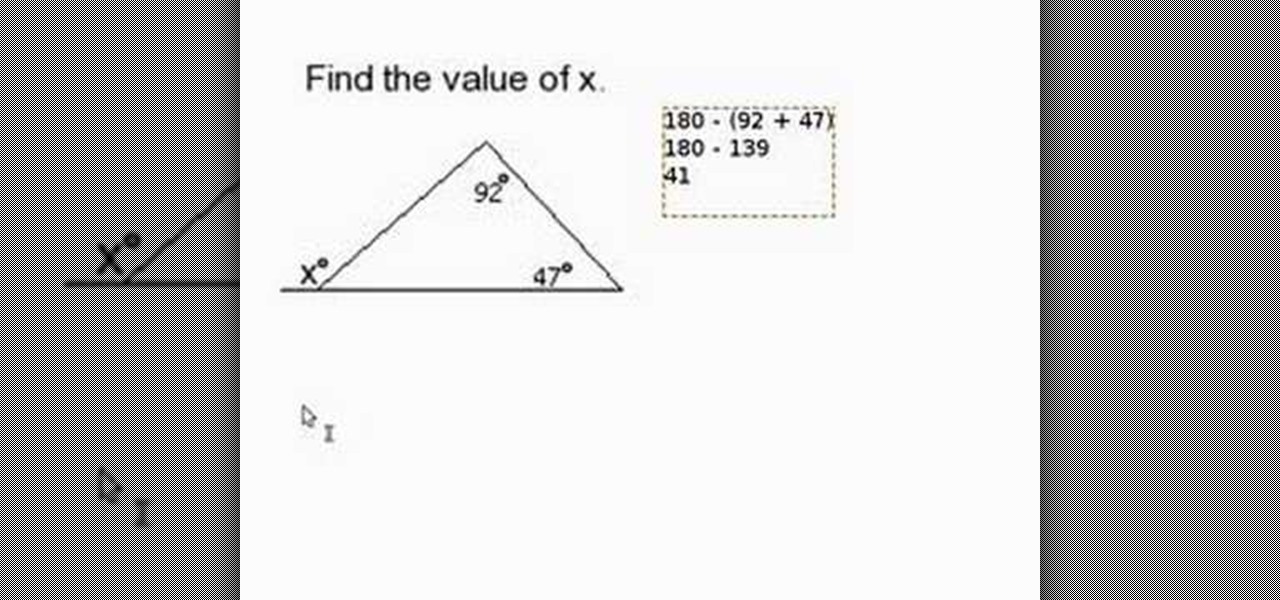
How To: Find a missing angle outside of a triangle
For people who are having problems with certain parts of geometry, this video will offer you advice on how to find a missing angle on the outside of a triangle when you are provided with the measurements of the other two angles in the triangle. Since the sum of the angles in a triangle is always 180 degrees, you should first take the sum of the other two angles and then subtract this from 180 in order to find the measurement of the missing angle in the triangle. Next, since there are also 180...
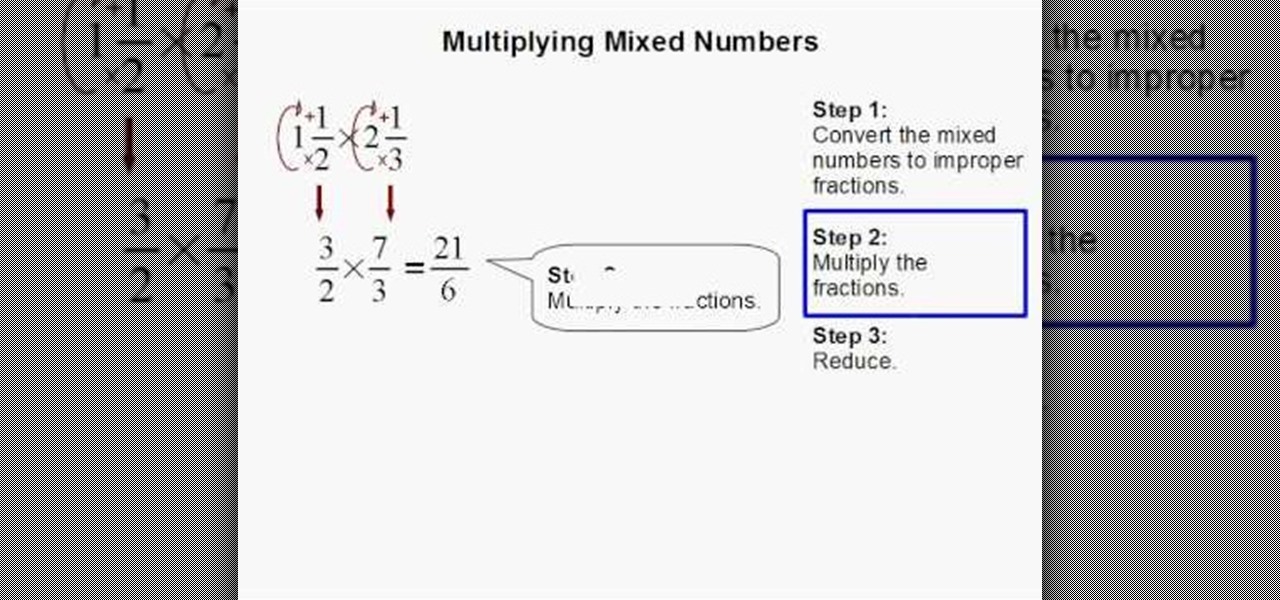
How To: Multiply two mixed numbers
Step 1: Convert the mixed numbers to improper fractions. ex: convert 1 1/2 * 2 1/3 to 3/2 * 7/3

How To: Remember "greater than" & "less than" symbols
This video shows you how to easily remember "greater than" and "less than" math symbols. The first thing you have to remember is that "less than" symbol looks like the letter L ("less than" symbol is "<"). When you see this sign, remember that < looks like L and means "less than". The other symbol, "greater than" does not look like the letter L, therefore it cannot be "less than" and it's easier to remember. The "greater than" symbol is ">". That's it! Good Luck!

How To: Find y-intercept with an equation in point slope form
In this tutorial the instructor shows how to find the Y-Intercept given the equation of the line in Point-Slope form. He shows how to do this with an example. He tells to substitute the value of x to zero to find out Y-Intercept as Y-Intercept is nothing but the point where the line meets x-axis, where the value of x co-ordinate is zero. By watching this simple tutorial you can easily compute the Y-intercept of an equation in point slope form.
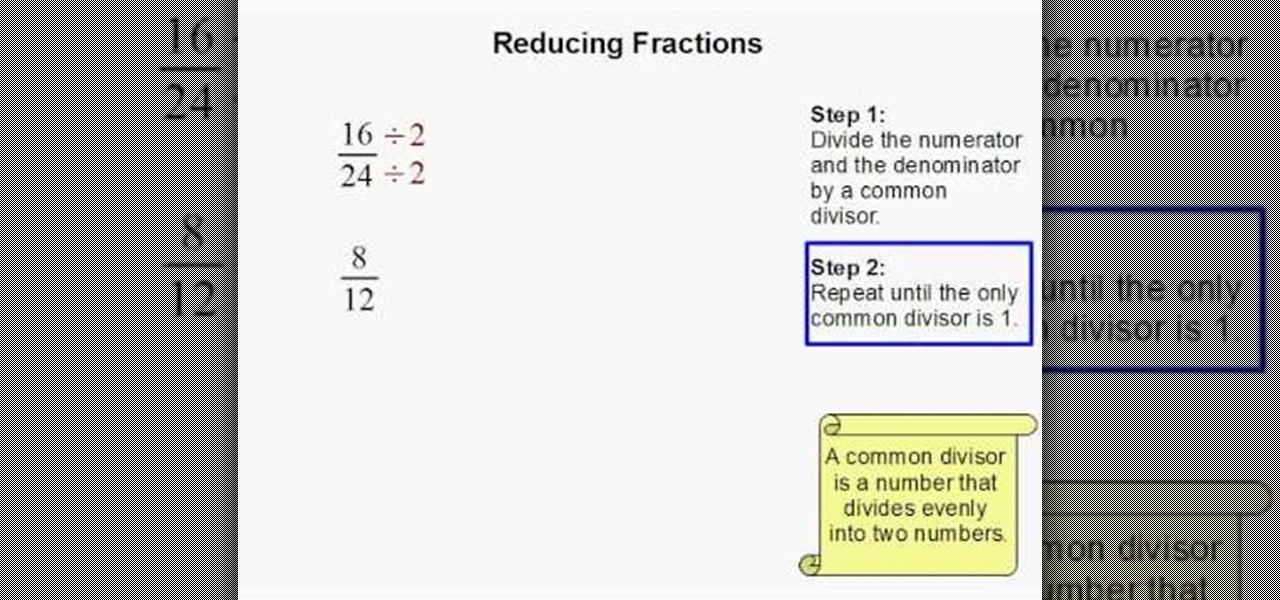
How To: Reduce a fraction in math
The above video is very informative to anyone who does not know the division of fractions. The author very neatly explains the meaning of a common divisor i.e. it is a number that divides two numbers evenly. Therefore, one must divide a fraction as many times until the remaining fraction has 1 as a divisor. It is very easy to find the common divisor. Both the numerator and the denominator must be divisible by that number. The author in the present video has done a good work.
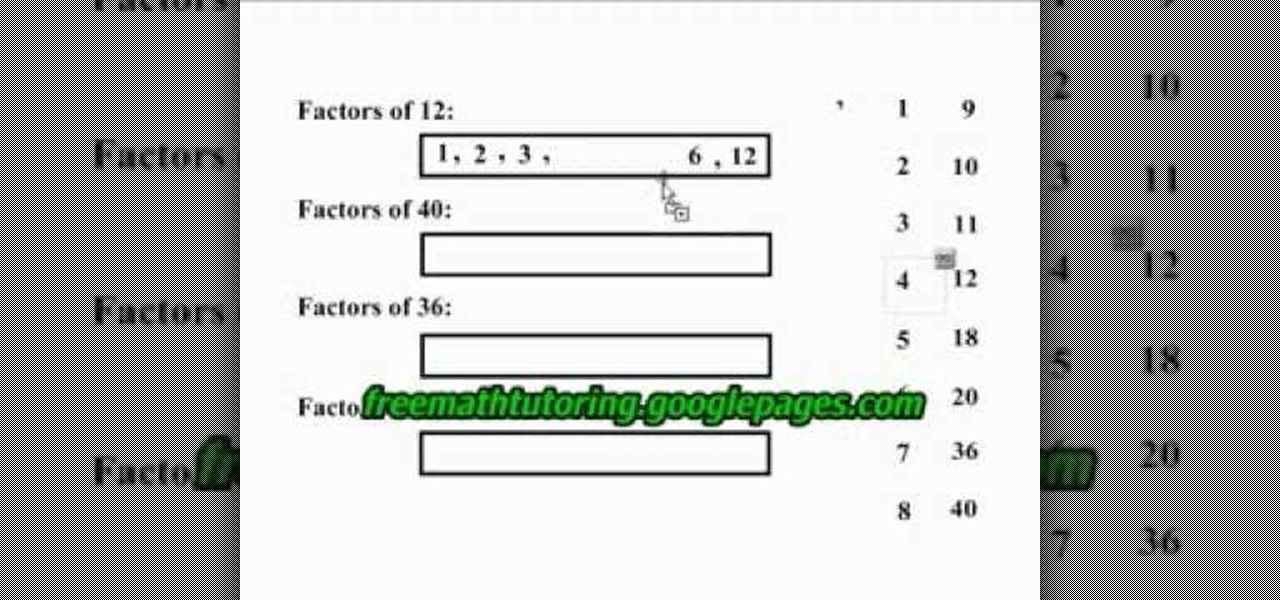
How To: List the factors of a number
In this tutorial the author shows how to factor a number. He says that factoring means to find all the smaller numbers which can be multiplied to obtain the original number. He says that the number one and the number it self are the factors of every number. Now to find the factor of a number he starts with 2 and tries to divide that number with 2. If he is able to divide it, it implies that 2 is a factor of that number. He now does this with each and every number between 1 and the number it s...

How To: Divide decimals with Mr Binkley
This video is provided by Mr. Binley. Let's learn this with an example, let's say that we want to divide 0.492 by 0.4, the most important thing remember while dividing the decimal numbers is that we need to convert the divisor into a whole number, here we need to convert 0.4 into a whole number. To do this we need to move the decimal to the right, then 0.4 becomes 4, now do the same thing to the dividend (0.492), move the decimal to the same location that we followed while moving the decimal ...
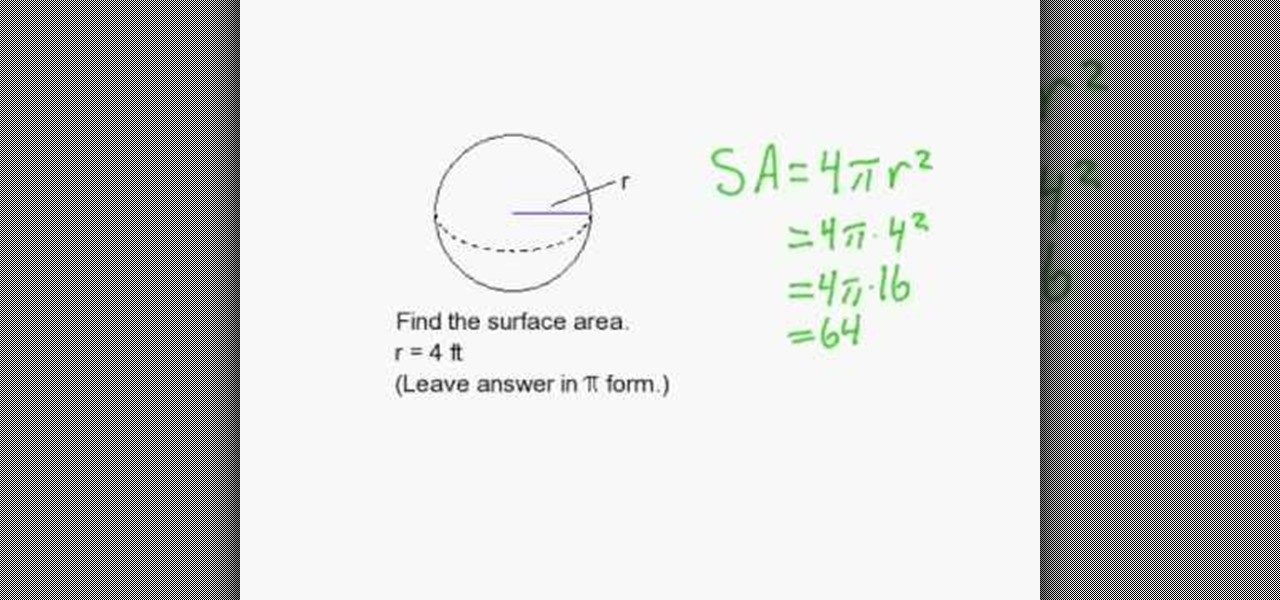
How To: Find the surface area of a sphere
In this tutorial the instructor shows how to find the surface area of a sphere. He explains the equation to calculate the surface area of a sphere as 4 * Pi * r * r , where r its the radius of the sphere. Now if you have the radius of the sphere, by substituting its value in this equation and substituting the value of Pi, you can obtain the surface area of a sphere. If you want to compute the surface area of a sphere watch this video where it is clearly explained how to compute it along with ...
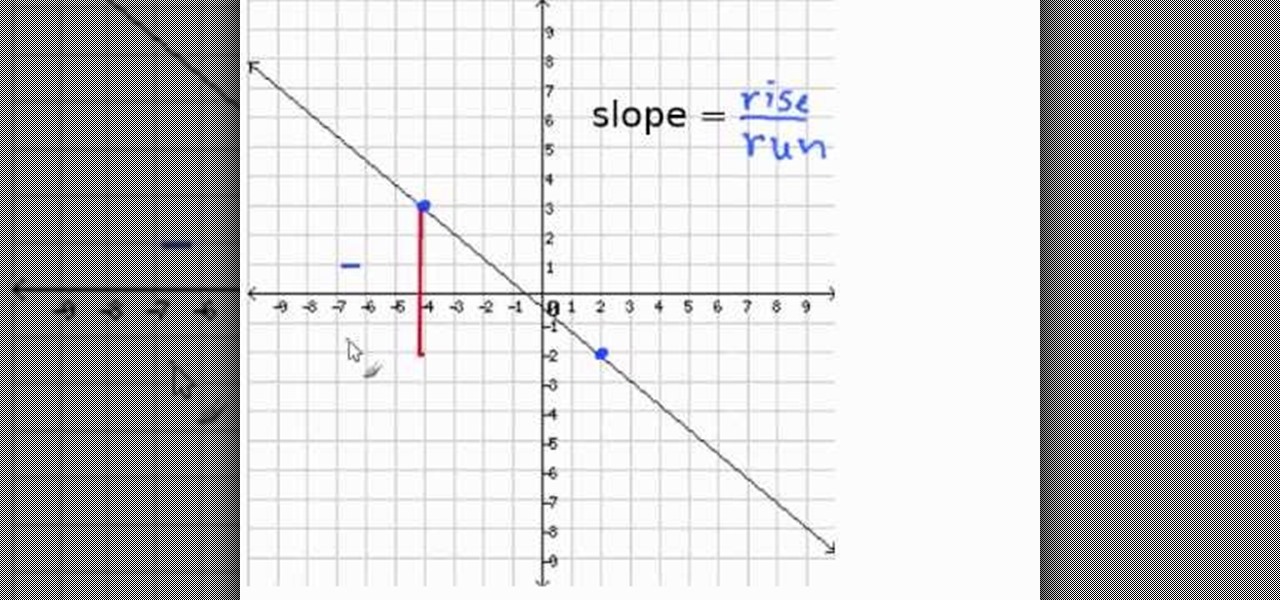
How To: Find the slope, given a graph
If you watch this video, you will learn what slope is, and how to find it. Slope is defined as rise divided by run, where rise in the increase the Y coordinate and run is the increase in the X coordinate. For example, if you pick two points, you can travel from the left point to the right point. However many points you go is the run. How far up you go is the rise. For example, if your rise is 4 and your run is 2, then you divide 4 by 2 to get your slope, 2. When you're finding the rise, if yo...

How To: Subtract numbers in yout head
This how-to video explains in detail about an alternate mental subtraction method.
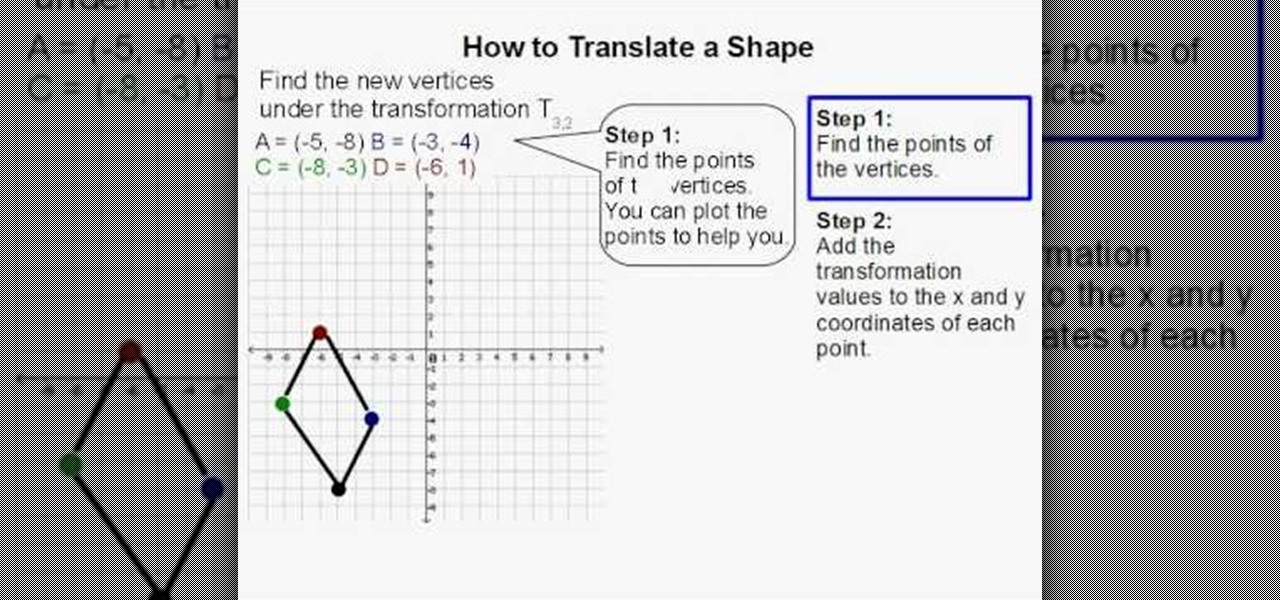
How To: Translate a shape
Learn how to translate shapes with a few simple steps. - First step: Find the new verticals under the transformation which are T3,2. Values are A=(-5,-8), B=(-3,-4), C=(-8,-3), D=(-6,1). Find the points of the verticals on the graph and connect the points one by one until you can get one shape.
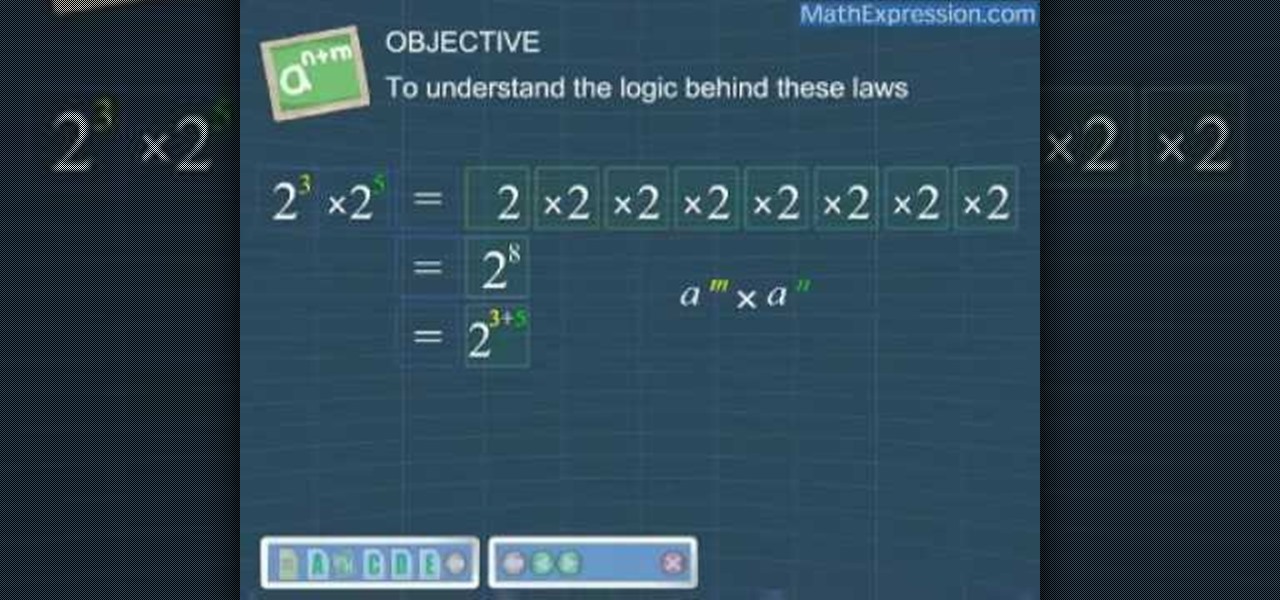
How To: Understand the basics of exponent laws
Before you can effectively use exponents, it is necessary to understand the laws behind them. First, in order to multiply a number raised to an exponent, by that number raised to another exponent, just add the exponents: for example, 2^5 * 2^2 is 2^(5+2), or 2^7. In short, a^m * a^n = a^(m+n). Similarly, dividing a number raised to an exponent by that number raised to another exponent can be done by subtracting the exponents: a^m / a^n = a^(m-n). To raise a number raised by an exponent to ano...

How To: Find the vertical asymptotes of rational functions
To find a vertical asymptote, you are trying to find values of x that produce 0 in the denominator but not in the numerator. If 0/0 occurs, that means you have a "hole" in the graph. A vertical asymptote is a place in the graph of infinite discontinuity, where the graph spikes off to positive or negative infinity. To find the vertical asymptote, set the denominator equal to zero and solve for x. Check that the values also do not give a zero in the nominator. If the values work, you have found...
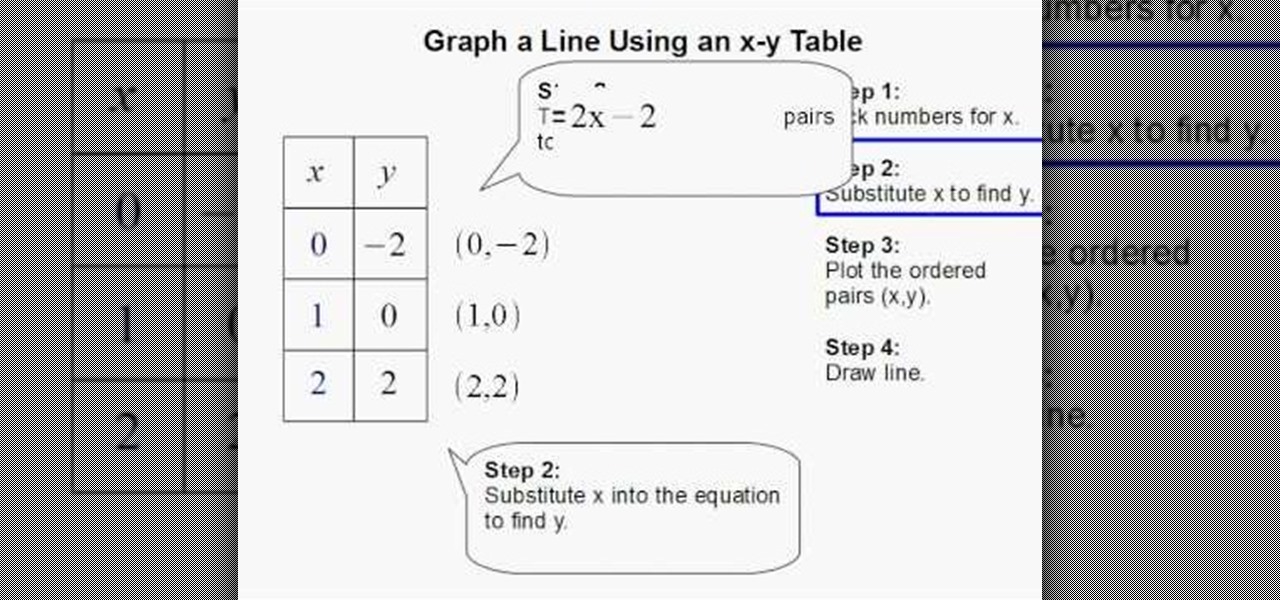
How To: Graph a line using an x-y table
In this video the instructor shows how to graph a line using X-Y table values. He specifies a four step approach. In the first step he picks numbers for the value of x. In the next step he substitutes the values of x in the equation of the line to obtain the corresponding y values, in the third step he plots these ordered pairs on a graph sheet. Finally in the fourth step he joins them resulting in a straight line for the given equation. This video clearly shows how to graph a line using an X...

How To: Find a slope of a line parallel/perpendicular to it
This video tells you how to find a slope of a parallel / perpendicular to it. In the equation y = mx + c, m is the slope. To calculate the slope of a line that is parallel to another line, you have to consider the rule m1 = m2 which means slope of the first line m1 is equal to the second line m2, if both the lines are parallel. Take the equation y = 2/3x - 7.2/3 is the slope. According to the rule m1 = 2/3 and so m2 = 2/3.Now to calculate the slope of perpendicular line you have another rule ...
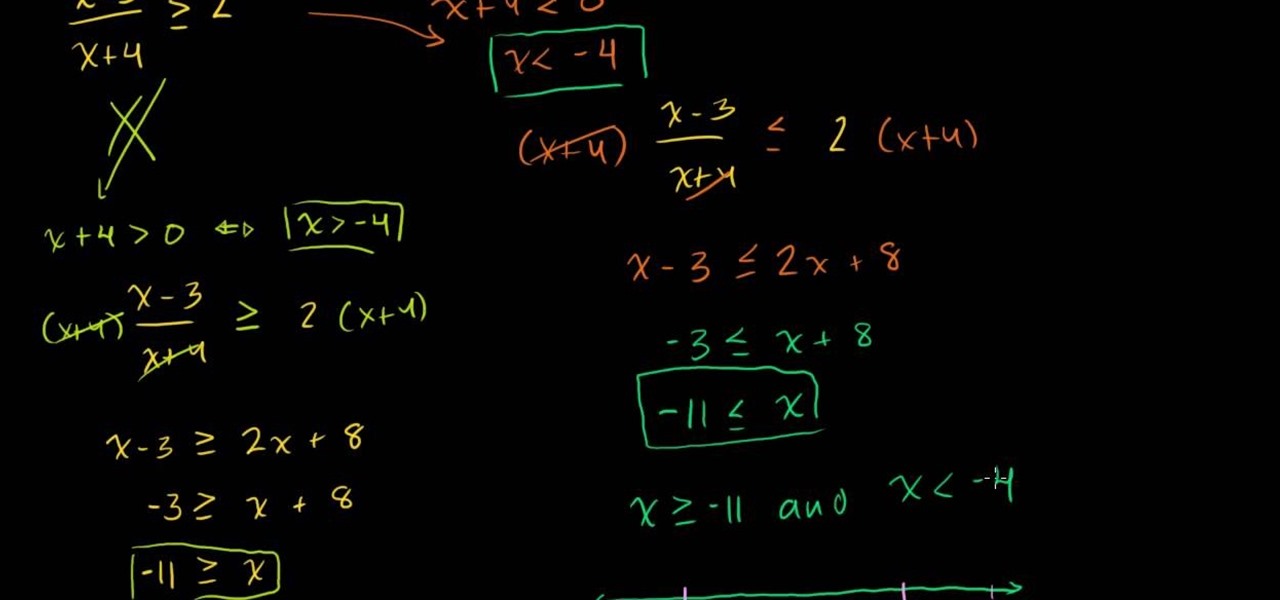
How To: Solve rational inequalities (intermediate level)
Struggling with math homework? An expert instructor from Khan Academy helps you work your way through the challenges of solving more difficult rational inequalities. Provides fantastic animated examples that demonstrate helpful tips, overcoming common problems with inequalities, and "simplifying" the problems of inequality simplification! Covers tricky complications such as swapping inequalities, understanding constraints, working with negative numbers, and working with zeros in equations. Po...
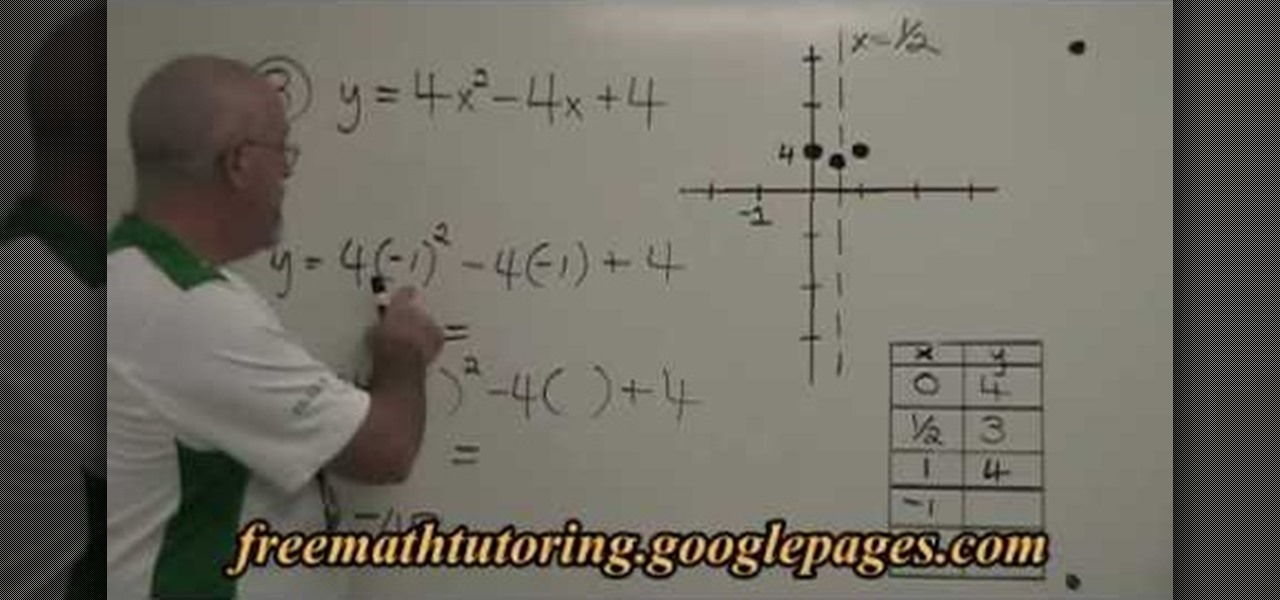
How To: Find extra points for a parabola (quadractic equation)
This is a mathematical educational video on how to find extra points for a parabola. In the first two examples there is no need for finding extra points as they have five points and have zeros of the parabola. In example 3 we need to find extra points. The equation is y=4xsquare-4x+4. You can take x= -1 and get the value for y. You will get a point now. Similarly you can substitute -2 for x in the same equation and get the value for y. Now you get another point. Now you can draw the parabola.
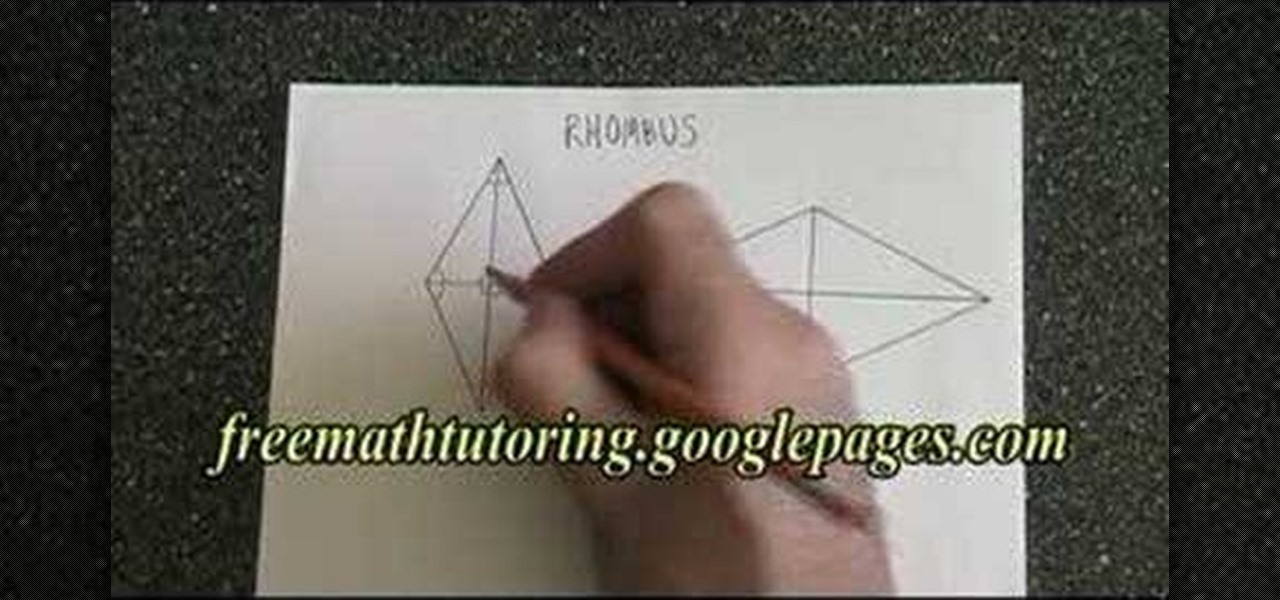
How To: Understand the properties of a rhombus in Geometry
In this math tutorial the instructor discusses the properties of a rhombus. He begins by saying that the properties of a rhombus are similar to the properties of a square. He says that the rhombus is a quadrilateral and hence the sum of internal angles of it is 360 degrees. He says that four sides of a rhombus are equal in length. He says that a rhombus has two diagonals which cross each other at their mid points and are perpendicular to each other but says that the lengths of diagonals are d...

How To: Compare fractions
A short video teaching you how to compare fractions. Starting with two fraction like three fourths and two over twelve. You cross multiply the denominator or the bottom number of three fourths which is 4 with the numerator or the top number of the second fraction which is 2. So the 8 that you come up with goes under the two twelfths. Now you do the same for the two fraction this time multiplying the denominator 12 with the numerator 3 coming up with 36. So now you have 36 under three fourths ...

How To: Use the midpoint formula to find midpoint of a line
In this video the tutor shows how to find the midpoint of a line. He goes on and gives a formula to find out the mid point of a line. The x coordinate of the mid point of a line is the average of the x-coordinates of the end points of that line. Similarly the y coordinate of the mid point of a line is the average of the y-coordinates of the end points of that line. He notes down the formula and explains it by taking an example. This video shows how to compute the mid point of a line given its...
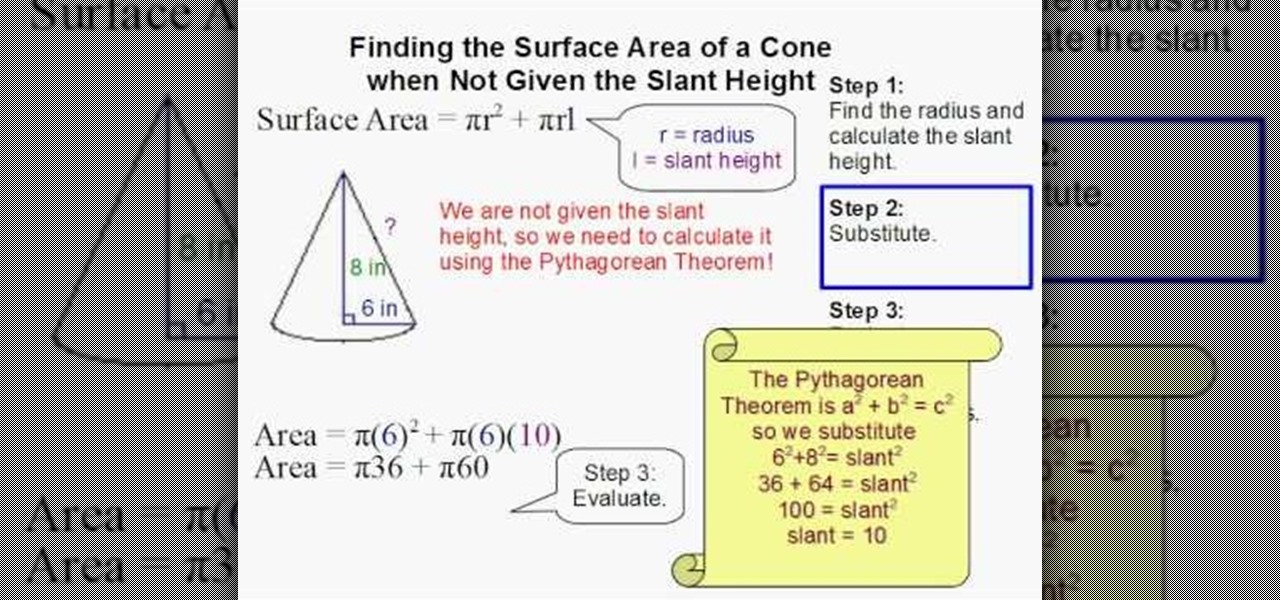
How To: Find the surface area of a cone without slant height
Math always seems hardest until someone shows you how to do the problem and then it all seems just so simple. This video will walk you through the process of finding the surface area of a cone when you also have to derive the slant height. Use this example to help with your other cone problems.

How To: Calculate lateral & total area of a cylinder
Steps involved in calculating the lateral surface and total area are:

How To: Calculate circular velocity & acceleration
In this video the tutors explain about the concepts of Circular Velocity and Acceleration. She explains the concepts using a real world small experiments. She shows that the equation to calculate circular velocity is v = (2 * Pi * r) / T, where r is the radius of the circle the object moves in, and T being its time period. Now she takes the values from the experiment and calculates the velocity of the other tutor who is the object that runs around in the circle for the experiment. She even co...

How To: Subtract mixed numbers with borrowing
This video teaches you to subtract mixed numbers with borrowing. Consider 2 mixed numbers. For example 8 and 2/7 and the other 5 and 4/5.You have to subtract 5 and 4/5 from 8 and 2/7. First you have to convert the fractions to their common denominator. To equate the denominators of these two fractions you have to multiply the first denominator with the numerator and the denominator of the second fraction and also multiply the numerator and denominator of the first fraction with the denominato...

How To: Divide basic numbers
This video shows you graphically how to learn to divide basic numbers. You are first shown how division works by dividing up money between cartoon characters, and this is then translated into a proper mathematical equation. The teacher does a very good job of showing us that division is an operation performed by everyone almost everyday at some level, and he also shows us how division is actually a reverse of multiplication. By watching this video, you'll be able to learn division of basic nu...
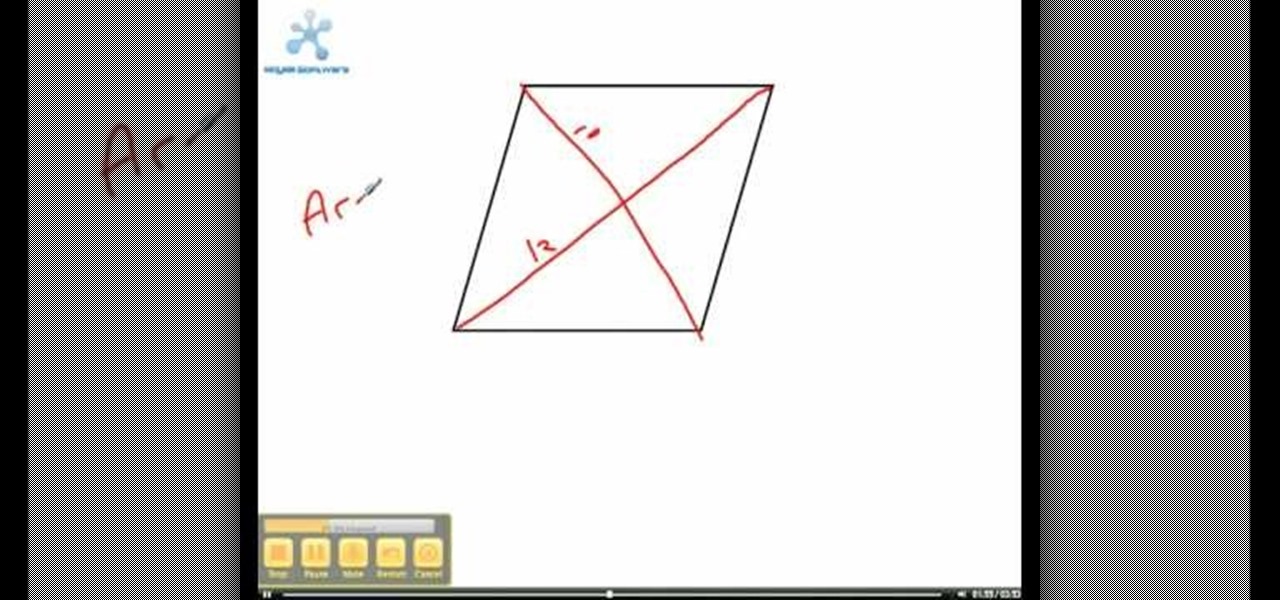
How To: Calculate the area of a rhombus
This is how to calculate the area of a rhombus. A rhombus is a quadrilateral shape in which all sides are congruent. A rhombus has two sets of parallel lines, the diagonals of which form 90-degree angles at the point they meet. Also the angles opposite to one another are congruent. The area of a rhombus can be gotten by multiplying both the diagonals and then dividing the total by 2. Say one of the diagonals is 10 and the other is 12, the area will be 10 x 12 = 120/2 = 60. That is how to calc...
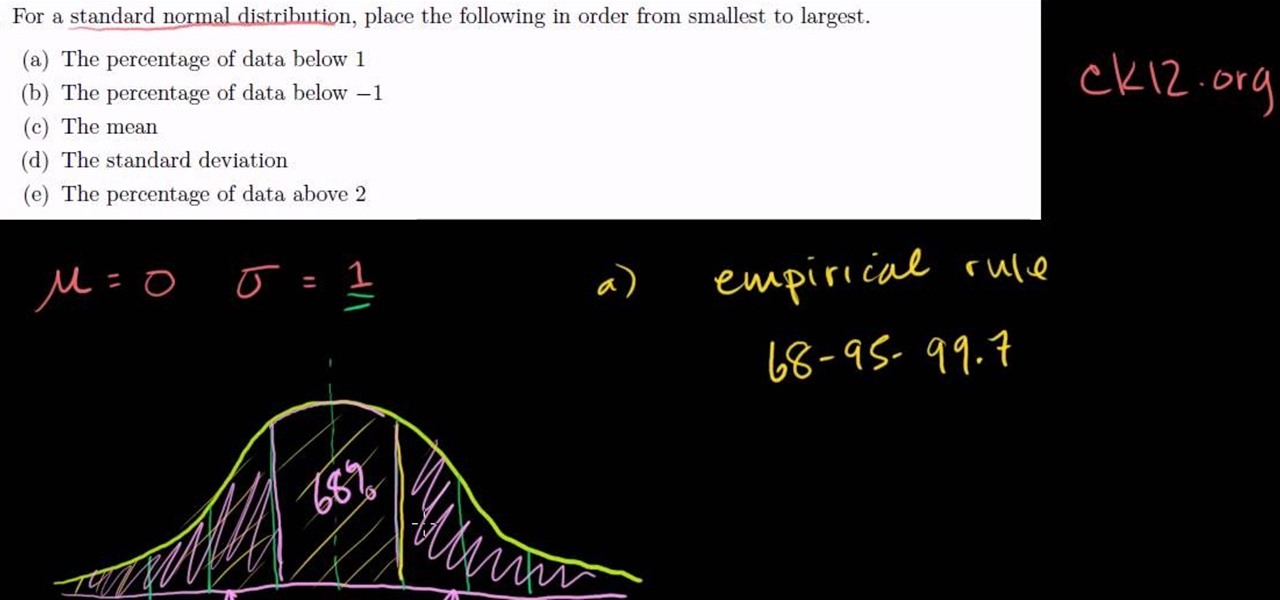
How To: Use the Empirical Rule w/ standard normal distribution
In this video tutorial the instructor explains about the concepts of standard normal distribution and the empirical rule and how to use it to solve an exercise. He starts by explaining about standard normal deviation saying that in a standard normal deviation the value of mean is zero and the value of standard deviation is one. Now he draws the standard normal deviation by drawing a bell curve on an axis. Now he points the mean and standard deviations on it. Now using these concepts he goes o...

How To: Solve formula problems in 8th grade Algebra
This video teaches "How to solve Formula Problems". You will be given numbers to replace all letters in the formula EXCEPT one.
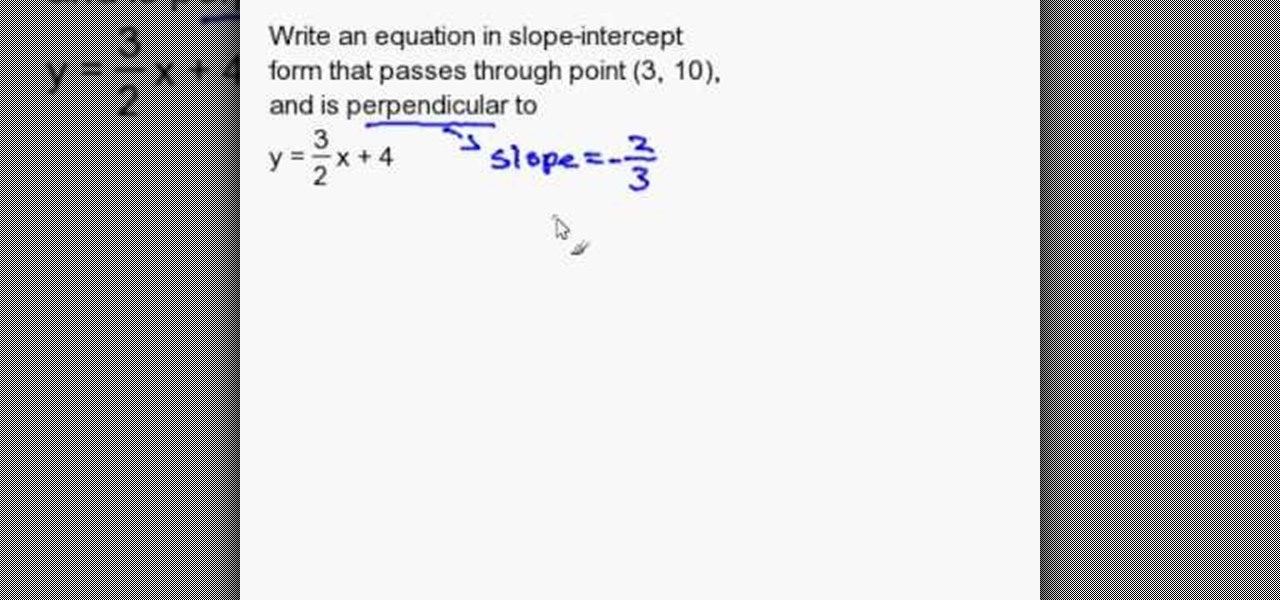
How To: Write a slope-intercept equation perpendicular to line
In this tutorial the instructor shows how to write a Slope-intercept equation that is perpendicular to a line and passes through a point. He shows how to do this by solving an example with sample values. He says that the slope of a line perpendicular to the original line is the negative inverse of the slope of original line. Now he writes down the slope value in the general equation y = mx + c, and by substituting the sample value in the equation he obtains the value of the Y-intercept c, thu...

How To: Find the volume of a cone
For anyone who is learning geometry and would like to learn or to review how to find the volume of a cone, this is the video for you to watch. The video provides you with both the simple formula for a cone as well as various examples which you can use to practice. The formula for finding the volume of a cone is 1/3 x pi x r^2 x h, where r is the radius of the base circle of the cone and h is the height of the cone.

How To: Draw a circle with a compass for Geometry
The first thing you have to do is draw a line of the same length as the radius of the circle you want to draw. Then, open the compass the same size as the line length you draw is. Rotate the compass and you will create a circle. Please note that drawing this on a single sheet of paper can be difficult because the paper can move. Also, you can try rotating the paper, instead of the compass.

How To: Solve inverse proportions
This video tutorial shows how to solve inverse proportions. The tutor says that in inverse proportion it works differently than in the direct proportion. He says that in inverse proportion more means less or less means more. He uses the example of driving a car to illustrate his idea. He says that if you drive a car with more speed, you take less time to reach a place i.e. here more speed means less time. He goes on and solves a problem involving inverse proportion explaining how to solve the...

How To: Find points of intersection in different equations
In this tutorial the instructor shows how to solve linear and quadratic equations. It is a liner quadratic system where he shows a parabola and a straight line and he intends to solve the points where the line intersects the parabola. Now he uses comparison to compare the values of y in both the equation resulting in a equation in x. Now he shows the factors of the obtained polynomial equation and there by finding the values of x coordinates. Now he substitutes these values of x in the origin...
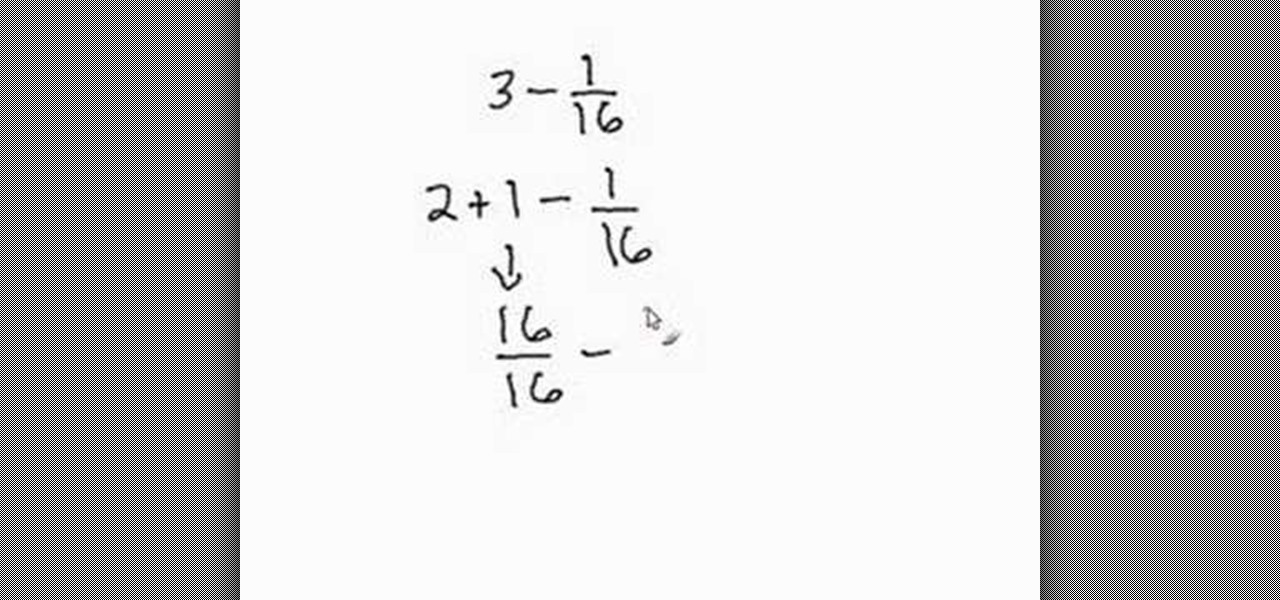
How To: Subtract fractions from a whole number
In order to subtract fractions from whole numbers you have to perform a few steps. First we have to borrow one from the whole number. So if you are subtracting 1/16 from 3, 3 becomes 2. Then you have to change the one you borrowed, so the 1 becomes 16 over 16 or 16/16 to match the common denominator in the fraction 1/16. So 16/16 - 1/16 = 15/16. Then you add the 2 that you had left after you borrowed the one from the whole number. The answer is 3 - 1/16 = 2 15/16.
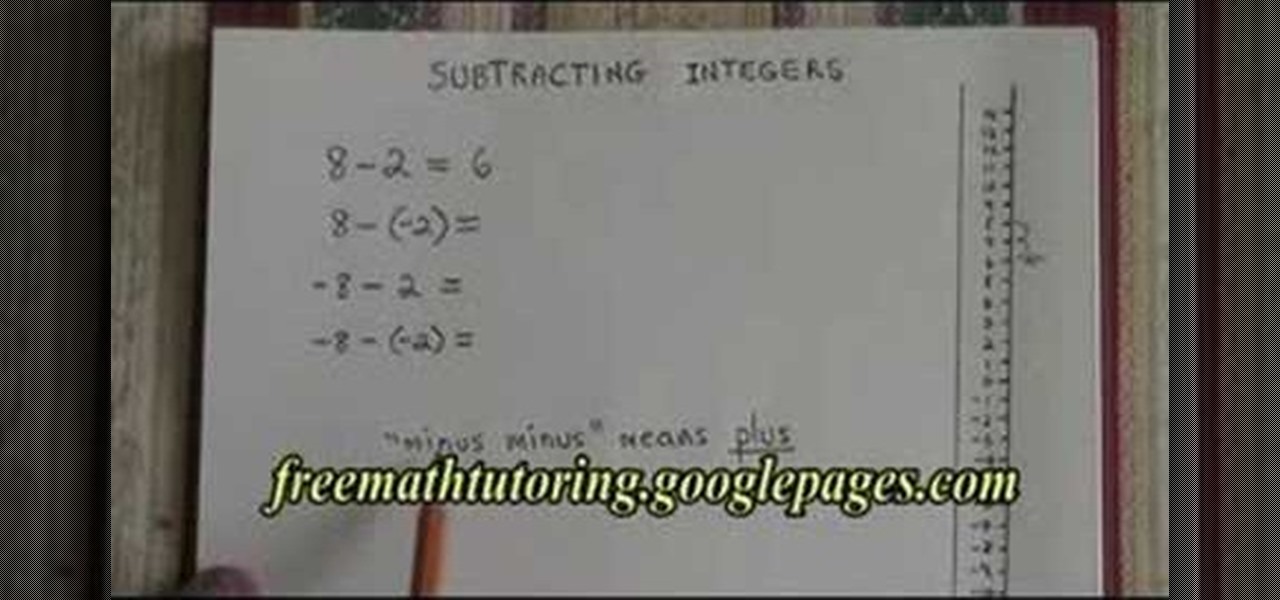
How To: Subtract integers
Working with integers is the basis of all mathematics. Subtracting is naturally a little more complicated than adding. If you are having trouble with subtraction, check out this video. This tutorial illustrates how to subtract integers, as used in high school math courses.

How To: Convert improper fractions to mixed numbers quickly
Watch this video to learn how to convert improper fractions to mixed numbers. For example, follow these steps. First step is one fraction value. For example 7/3. Second step is divide the numerator by denominator means when 7 divide 3 you can get remainder as 1. Means 7 before value can multiply with the 6 so you can subtract 7-6=1 that is remainder. Multiplied value of 3 nothing but 2 is multiplication of the mixed numbers remainder take it as a numerator and denominator is always take it as...

How To: Divide polynomials
When you divide polynomials, you subtract the exponents. This video is filmed in such a way that the camera is focused on a piece of paper with polynomials while the narrator talks the viewer through each step. He is very clear with showing his work step-by-step while he dictates. Students who are new to dividing polynomials will find this video to be very clear and easy to understand. It's a short video that goes straight to the point which is what people look for when they are seeking homew...

How To: Use the Cosine Law
In this video tutorial the author shows how to use the Cosine Law. He shows how to find an angle of a triangle where he know all the sides of a triangle, using the cosine Law. He uses a lower case letter to designate a side and a capital letter to designate an angel apposite to that side. He gives the formula for the cosine law using a triangle as an example. Now he goes on and demonstrates how to use a scientific calculate. He shows how to use the degree mode in the calculator to solve these...

How To: Do long division
For anyone who has ever struggled with long division, this video offers some tips on how to perform this seemingly daunting task with relative ease. The example provided in this video is a very useful one and by following the steps of this video, you will be able to do long division easily. Starting from the right side of the number which is being divided, add 0's as place holders until you arrive at a number which can be divided by the number you want to divide by. Perform this one simple di...






